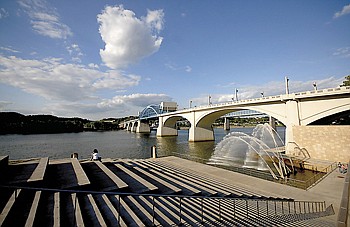The restored Market Street Bridge, the largest drawbridge of its type east of the Mississippi River, is expected to pick up a new honor in coming weeks - a spot on the National Register of Historic Places.
The bridge, opened in 1917 after three years of construction, is still a working drawbridge and is among 10 Tennessee sites up for a National Historic Register vote later this month.
Technically, it's known as a bascule truss bridge - "bascule" being French for "seesaw" or "balance" and referring to the bridge's counterweights, which help raise and lower it.
Renamed the Chief John Ross Bridge in 1950, the span first was called the "Million-dollar Bridge." Just before its two-year, $13 million restoration began in 2005, the Tennessee Department of Transportation qualified it as one of the state's "worst" spans.
Commonly called the Market Street Bridge, the concrete-and-steel structure links Chattanooga's downtown waterfront with the city's revitalized North Shore. Its neighbor upstream, the Walnut Street Bridge, was placed on the National Historic Register in 1991.
Claudette Stager, the Tennessee Historical Commission's historic preservation specialist, said the vote is an almost sure bet.
"We said it has statewide significance. I don't think there will be any problems," Stager said.
The next hurdle will be a review by the National Park Service, which administers the National Register of Historic Places, she said.
On Friday, the Tennessee Department of Transportation, which funded the bridge's renovation with federal highway and bridge money, applauded the register nomination.
Ray Rucker, TDOT's assistant regional director in the Chattanooga office, said the preservation was accomplished in a way that improved the structure while maintaining the bridge's historical character.
"We are very pleased that this beautiful bridge, which has meant so much to this city, is being considered for this significant recognition," he said. "As one of the few remaining working drawbridges in the country, this double-leaf bascule span has been a distinctive landmark in Chattanooga for nearly 100 years."
Paul Archambault, historian for the Southeast Tennessee Development District, wrote the nomination.
"It represents a rare engineering marvel in the Southeast United Stations region. At 310 feet, the double-leaf steel bascule lift was the largest span of its kind in the world when the bridge opened for traffic," the nomination states. "The six concrete arches made it the largest concrete bridge in the South at that time."
